Staving off Mass Extinction with the Big Anomaly
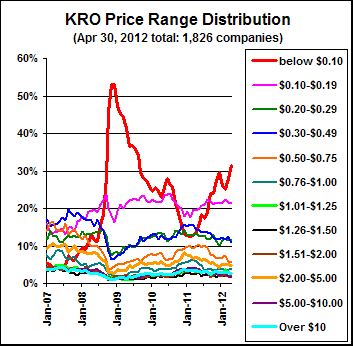 The 2008 financial crisis produced a near death experience for the junior resource sector covered by Kaiser Research Online. The adjacent chart shows how the number of KRO companies trading below a dime soared from less than 10% in early 2008 to more than 50% by the end of that year. Since most of the KRO companies are TSXV listed resource juniors, the future looked very grim at the start of 2009. However, much to the surprise of many observers who expected a grinding bear market similar to what followed the Bre-X Betrayal in 1997 before the China driven breakout in 2003, the resource sector enjoyed a remarkable rebound that peaked in early Q2 of 2011. The engines driving the resource sector rebound were the $585 billion fiscal stimulus China directed at its infrastructure, which drove base metal prices back up, in the case of copper higher than the pre-crash peak, and investor demand for gold and silver driven by anxiety that the monetary easing deployed to stabilize the financial system would ultimately be a failure. Now we have a triple whammy in the form of a slowing Chinese economy in the midst of a troubling leadership transition, a dysfunctional Eurozone on the threshold of collapse, and an election year battle in the United States whose outcome hinges on how poorly the American economy does during the rest of the year. These macroeconomic-ideological trends have been in place since Q2 of 2011, and their negative effect on the junior resource sector is shown by the fact that KRO companies trading below a dime have jumped from less than 15% in Q1 of 2011 to over 30% by the end of April 2012. This trend worsened during May, and this time the junior resource sector faces a mass extinction crisis.
The 2008 financial crisis produced a near death experience for the junior resource sector covered by Kaiser Research Online. The adjacent chart shows how the number of KRO companies trading below a dime soared from less than 10% in early 2008 to more than 50% by the end of that year. Since most of the KRO companies are TSXV listed resource juniors, the future looked very grim at the start of 2009. However, much to the surprise of many observers who expected a grinding bear market similar to what followed the Bre-X Betrayal in 1997 before the China driven breakout in 2003, the resource sector enjoyed a remarkable rebound that peaked in early Q2 of 2011. The engines driving the resource sector rebound were the $585 billion fiscal stimulus China directed at its infrastructure, which drove base metal prices back up, in the case of copper higher than the pre-crash peak, and investor demand for gold and silver driven by anxiety that the monetary easing deployed to stabilize the financial system would ultimately be a failure. Now we have a triple whammy in the form of a slowing Chinese economy in the midst of a troubling leadership transition, a dysfunctional Eurozone on the threshold of collapse, and an election year battle in the United States whose outcome hinges on how poorly the American economy does during the rest of the year. These macroeconomic-ideological trends have been in place since Q2 of 2011, and their negative effect on the junior resource sector is shown by the fact that KRO companies trading below a dime have jumped from less than 15% in Q1 of 2011 to over 30% by the end of April 2012. This trend worsened during May, and this time the junior resource sector faces a mass extinction crisis.
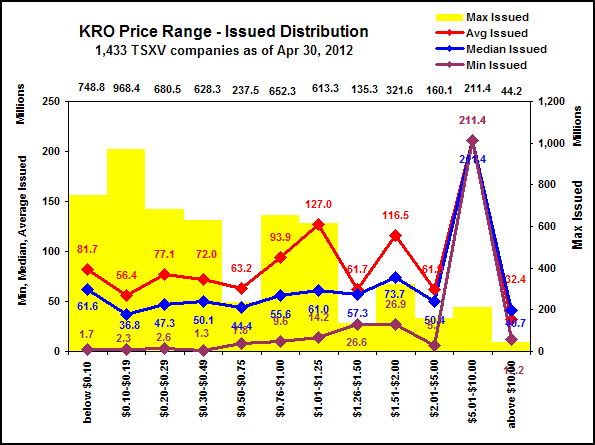
KRO has been tracking working capital and issued capitalization figures via quarterly filings since the launch of our KRO search engine in December 2012. This has enabled us to produce price range distribution charts for the 1,433 active TSXV listings that are featured at KRO. These are companies generally involved in the resource sector, though a handful may have wandered off into other sectors such as energy. The above "issued distribution" chart reveals the range of issued stock for companies trading in the various price ranges. The yellow bar corresponds to the right axis and represents the maximum number of shares a company has issued in each price range (the exact figure is at the top of the chart). The lines relate to the left axis, with the purple line representing the minimum issued, the blue line the median issued, and the red line the average issued. In the "working capital distribution" chart below the yellow bar indicates what percentage of the 1,433 TSXV listings were in each price range on April 30, with the exact figure at the top. It is shocking to note that 1,250 resource juniors or 87.2% were trading below $0.50. In the "working capital" chart the red line is the average working capital based on the most recently filed financials, while the blue line is the median figure for each price range.
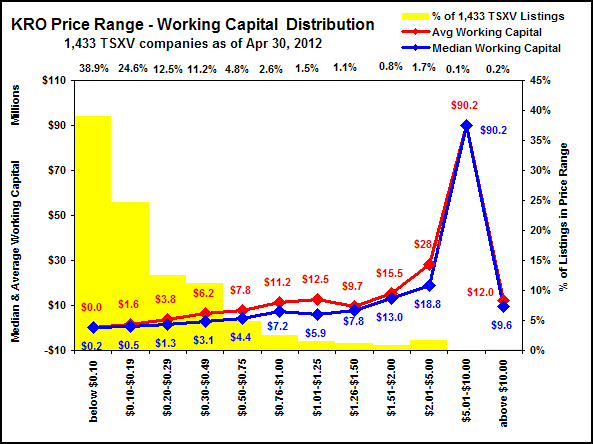
Because each group has extremes in terms of issued stock, and positive or negative working capital, the average issued and working capital figures can be misleading. The median figure is more useful because it represents the number at which half of the listings in the price range are below and half above. It is very sobering to realize that half the 557 companies trading below a dime have less than $200,000 working capital and half, which may not be the same half, have more than 61.6 million shares issued. The large number of listings with capitalizations in excess of 60 million came about because after the 2008 Crash management typically chose to defer a rollback, and in the midst of the V-shaped 2009-2010 rebound undertook dilutionary financings generally below $0.20 that were taken down by the street (brokers) and sophisticated investors who all hoped to unload their paper at 100%-200% markups. While this was achieved in some cases, today it is not happening, and placees who bought paper as low as $0.05 during the past year have encountered no after-market and are sitting on losses. There is very little new money available for juniors with bloated capital structures and depleted treasuries, even if they conduct a rollback and try to refinance at prices following another 90% post-rollback price decline.
A bottom-fisher would want to focus on those juniors with more than $200,000 working capital and less than 61.6 million shares issued. This KRO Search (less than $0.10, WC greater than $200,000, less than 50 million issued) generated 123 companies on May 22, 2012. For the 352 stocks trading $0.10-$0.19 the median issued is 36.8 million shares and median working capital is $500,000. The same KRO Search ($0.10-$0.19, greater than $500,000 WC and less than 50 million issued) also generates about 100 hits. KRO members can use the median figures in the distribution charts to craft narrower searches in pursuit of structurally undamaged, financially well-endowed companies that may qualify as decent bottom-fish if there are not other problems.
There are a lot of potential bottom-fish trading below $0.20, but we are not ready to publish a new bottom-fish edition. We closed out our 2009 and 2010 Bottom-Fish Editions at the end of 2011 but have not published a 2012 Bottom-Fish Edition for two reasons: 1) we do not see a positive resolution of the above-mentioned macroeconomic-ideological trends that takes off the downward pressure on metal prices before 2013, and, 2) our analysis suggests that the financial and structural condition of the juniors is so poor that a contagion of stock consolidations will wipe out the shareholdings in more than 500 TSXV listings. A smart bottom-fisher should be able to avoid rollback candidates, but the current situation is so dire that companies in no need of a rollback will undertake one because everybody else is doing so. In this scenario the institutional investor will continue to withdraw capital from the resource sector, and the retail investor will stay on the sidelines as he witnesses the obliteration of already owned paper by the tidal wave of rollbacks.
But that is only part of the problem. There is a bigger problem related to the difficulty in refinancing rolled back juniors which causes me to fret that the industry is facing a mass extinction crisis rather than just a much needed attrition of superfluous juniors. The maturation of the junior resource sector during the past decade, where it became feasible for the management teams of resource juniors to fund and execute the exploration-development cycle beyond the discovery stage all the way to commercial production, has substantially raised the bar for what counts as a worthy project, be it an exploration target or an existing deposit. When juniors who have rolled their stock back below 10 million issued through ratios as high as 20:1 attempt to refinance their companies, they will not find takers unless there is a strong exploration target backed by a geologically competent management team - a condition that would qualify a junior as a Big Anomaly play - or an existing deposit whose positive economics requires metal prices to stay exactly where they are today. However, if such an asset is present in a rolled back company, management will stand accused of stealing from minority shareholders. In my view the rest of 2012 represents a window when it will be possible to find dirt cheap juniors with lots of stock outstanding that either have a Big Anomaly play, or an advanced project which will prove severely undervalued if the collective fear of a global macroeconomic train wreck proves unfounded. The bottom-fishing window opening up will be exhilarating and terrifying because the opportunity to make 1,000% plus scores exists, but the risk also exists that these rewards will be snatched away by thieving insiders or the actualization of fears about global economic recession that may spiral into a depression.
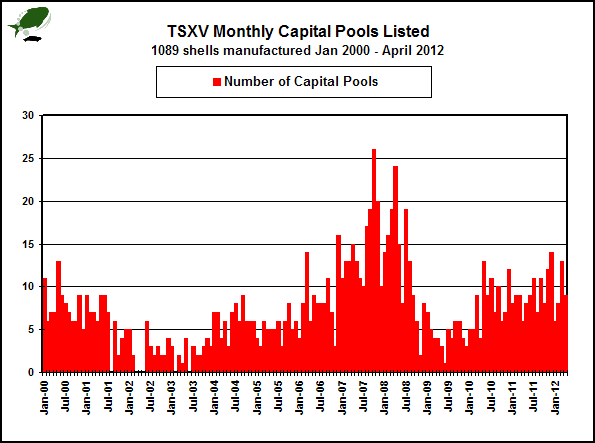
During the eighties and nineties the best way for bottom-fishers to make a big score was to home in on shells, but today the resource sector shell ranks among the best way to make money dead or vanish. The coming plethora of rolled back shells will encounter competition in generating a new story from a surplus of capital pool shells whose manufacture the Canadian brokerage industry ramped up during the past year. A CPC has 18 months to do a qualifying transaction, though the TSXV will grant extensions as it did after the 2008 Crash. A CPC reverse takeover is the preferred route to go public with an advanced asset, which means that the rolled back resource juniors will have a hard time latching onto advanced projects. Unfortunately for the CPC market, most of the good private projects were taken public during the ounces-pounds in the ground cycle of the past decade. The good projects were taken over during the past decade in bids exceeding $100 billion in value, and the rest sit in juniors which have been in a downtrend since the start of 2011 because of the embedded market expectation that the future holds lower metal prices and thus lower or possibly zero valuations for these projects. In my view the capital pool market is dead, but that assumes the Canadian brokerage industry has purged itself of stupidity.
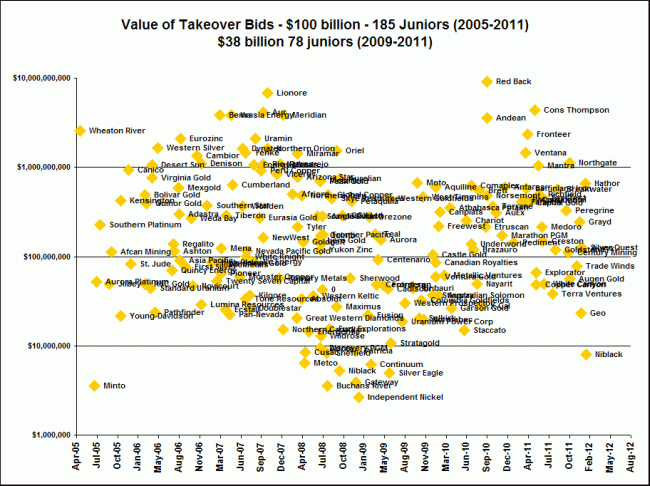
Because it costs about $200,000 annually to maintain a public listing many of these post rollback shells will disappear over the next couple years unless we do witness The Return of the Big Anomaly, my phrase for the idea that the resource sector pendulum is swinging back to the 1983-2002 period when junior resource sector speculation was all about discovery exploration, as opposed to indirect speculation on metal price trends during 2003-2010 which required a focus on discounted cash flow model based number-crunching, an activity beloved by fund managers eager to cover their asses but loathed by retail investors who preferred the mystery and rumors of discovery plays from the era that produced Eskay Creek, Ekati, Voisey's Bay, Pierina and Busang.
My sense is that investors are sick and tired hearing about macroeconomic drivel and ideological nonsense, and want a return to the days when the goal was to buy stock in a junior making a discovery so big and rich it does not matter if the price of the discovery's key metal takes a 25% dump the next day. During the height of speculation about Voisey's Bay absolutely nobody cared about the price of nickel, nor did anybody during the Pierina speculation pay attention to gold bug conspiracy theories or the sanctimonious finger-wagging of libertarians. Conferences used to be fun when they were a swirl of rumors and insights; today they are boring because all we seem to hear are lectures about investment style, the incompetence of the people running various branches of government, and extrapolations or denunciations of macroeconomic super-cycles.
The good thing about the sector's journey into the advanced portion of the exploration-development cycle during the past decade is that the juniors now have at their disposal the expertise to take projects well beyond discovery, and there is an audience of institutional investors on the sidelines with the knowledge and capital to take discovery plays to the next level without resorting to a farmout to a major, or capitulating to a low priced takeover bid. But to stave of a mass extinction in the junior resource sector we need companies with damaged structures to dress up their best exploration target as a Big Anomaly, and spend or raise their last nickel for a Hail Mary Pass drill program. They need to do this before doing a rollback and they need to do this publicly so that when one of those passes turns into a world class touchdown, lots of different shareholders benefit and everybody who did not buy the stock will slap themselves on the head exclaiming, "it was so obvious". That will cause the glass to switch from half-empty to half-full, and the retail investor will rush from the sideline looking for other Big Anomaly plays that are no longer half-empty. That will make conferences exciting and newsletter writers relevant again, because that will be when it matters to know who has what and where it is going. Our focus at KRO will continue to be on what we believe to be undervalued advanced projects, but we will be increasingly looking at old-fashioned exploration plays where management can present us with a well articulated and geologically supported Big Anomaly.
Last week during the New York Hard Assets Conference I had a Video Chat with Al Korelin about the state of things. I didn't feel like talking about the usual stuff so I disagreed with Al a couple times and changed the subject to express my view that we should flush the macroeconomic/ideology narrative down the toilet and focus on more exciting stuff like early stage exploration plays. Surprisingly, I am not really an outlier in this regard. Al at one point seemed to welcome this shift of the narrative to company specific stories, and later when chatting with Rick Rule I was stunned to hear that he also thinks the time is right for the market to shift its attention back to discovery exploration.
Of course, Rick's rule is that the only exploration junior worth buying is one which uses its geological talents to generate prospects it religiously farms out to other companies, usually leaving the "smart" junior with a minority interest in any discovery. One of Rick's employees, who shall remain nameless, and I later had a good time bashing Rick's prospect generator farmout model because of the tendency of adherents to disobey the Rule and come up with major 100% owned discoveries. Rule does have the last laugh because his overbearing disapproval of deviation from the rule creates a discipline among his disciples that compels them to buck the rule only when they really think the wrath of Rick is worth the risk, generally with an outcome extremely favorable to Rule's pocketbook. Unfortunately, if my analysis of the looming mass extinction crisis is correct, the prospect generators will not find any junior farmout partners with the will and means to option a prospect. To stave off this predicament the market needs a Big Anomaly discovery, which is why Rick Rule, myself, and many others are scouring the landscape for a Big Anomaly winner that does not too quickly become an instant success story in the style of Aurelian which did nothing to redeem the Bre-X Betrayal.